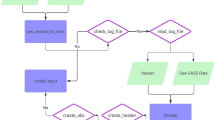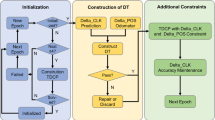Abstract
GLONASS precise point positioning (PPP) performance is affected by the inter-frequency biases (IFBs) due to the application of frequency division multiple access technique. In this contribution, the impact of GLONASS pseudorange IFBs on convergence performance and positioning accuracy of GLONASS-only and GPS + GLONASS PPP based on undifferenced and uncombined observation models is investigated. Through a re-parameterization process, the following four pseudorange IFB handling schemes were proposed: neglecting IFBs, modeling IFBs as a linear or quadratic polynomial function of frequency number, and estimating IFBs for each GLONASS satellite. One week of GNSS observation data from 132 International GNSS Service stations was selected to investigate the contribution of simultaneous estimation of GLONASS pseudorange IFBs on GLONASS-only and combined GPS + GLONASS PPP in both static and kinematic modes. The results show that considering IFBs can speed up the convergence of PPP using GLONASS observations by more than 20%. Apart from GLONASS-only kinematic PPP, the positioning accuracy of GLONASS-only and GPS + GLONASS PPP is comparable among the four schemes. Overall, the scheme of estimating IFBs for each GLONASS satellite outperforms the other schemes in both convergence time reduction and positioning accuracy improvement, which indicates that the GLONASS IFBs may not strictly obey a linear or quadratic function relationship with the frequency number.








Similar content being viewed by others
Abbreviations
- PPP:
-
Precise point positioning
- GNSS:
-
Global Navigation Satellite System
- GPS:
-
Global Positioning System
- BDS:
-
BeiDou Navigation Satellite System
- IFB:
-
Inter-frequency bias
- UCD:
-
Uncalibrated code delay
- UPD:
-
Uncalibrated phase delay
- DCB:
-
Differential code bias
- PRN:
-
Pseudo-random noise
- IGS:
-
International GNSS service
- MGEX:
-
Multi-GNSS experiment
- CODE:
-
Center for orbit determination in Europe
- ESA:
-
European Space Agency
- ISB:
-
Inter-system bias
- ISFB:
-
Inter-system and inter-frequency bias
- DOY:
-
Day of year
- PANDA:
-
Positioning and navigation data analyst
- GDOP:
-
Geometric dilution of precision
References
Aggrey J, Bisnath S (2016) Dependence of GLONASS pseudorange inter-frequency bias on receiver-antenna combination and impact on precise point positioning. Navigation 63(4):379–391
Al-Shaery A, Zhang S, Rizos C (2013) An enhanced calibration method of GLONASS inter-channel bias for GNSS RTK. GPS Solut 17(2):165–173
Banville S, Collins P, Lahaye F (2013) GLONASS ambiguity resolution of mixed receiver types without external calibration. GPS Solut 17(3):275–282
Blewitt G (1989) Carrier phase ambiguity resolution for the global positioning system applied to geodetic baselines up to 2000 km. J Geophys Res 94(B8):10187–10203
Bock Y, Melgar D (2016) Physical applications of GPS geodesy: a review. Rep Prog Phys 79(10):106801. https://doi.org/10.1088/0034-4885/79/10/106801
Boehm J, Niell A, Tregoning P, Schuh H (2006) Global mapping function (GMF): a new empirical mapping function based on numerical weather model data. Geophys Res Lett 33:L07304. https://doi.org/10.1029/2005GL025546
Cai C, Gao Y (2013a) GLONASS-based precise point positioning and performance analysis. Adv Space Res 51(3):514–524
Cai C, Gao Y (2013b) Modeling and assessment of combined GPS/GLONASS precise point positioning. GPS Solut 17(2):223–236
Chen Y, Yuan Y, Ding W, Zhang B, Liu T (2017) GLONASS pseudorange inter-channel biases considerations when jointly estimating GPS and GLONASS clock offset. GPS Solut. https://doi.org/10.1007/s10291-017-0630-9
de Oliveira PS, Morel L, Fund F, Legros R, Monico JFG, Durand S, Durand F (2017) Modeling tropospheric wet delays with dense and sparse network configurations for PPP-RTK. GPS Solut 21(1):237–250
Fritsche M, Sosnica K, Rodríguez-Solano C, Steigenberger P, Dietrich R, Dach R, Wang K, Hugentobler U, Rothacher M (2014) Homogeneous reprocessing of GPS, GLONASS and SLR observations. J Geod 88(7):625–642
Geng J, Bock Y (2016) GLONASS fractional-cycle bias estimation across inhomogeneous receivers for PPP ambiguity resolution. J Geod 90(4):379–396
Guo F, Zhang X, Wang J (2015) Timing group delay and differential code bias corrections for BeiDou positioning. J Geod 89(5):427–445
Guo F, Zhang X, Wang J, Ren X (2016) Modeling and assessment of triple-frequency BDS precise point positioning. J Geod 90(11):1223–1235
Guo F, Li X, Zhang X, Wang J (2017) The contribution of multi-GNSS experiment (MGEX) to precise point positioning. Adv Space Res 59:2714–2725
Hatch R (1982) The synergism of GPS code and carrier measurements. In: Proceedings of the third international symposium on satellite Doppler positioning at physical sciences laboratory of New Mexico State University, 8–12 Feb 1982, vol 2, pp 1213–1231
Kouba J (2015) A guide to using international GNSS service (IGS) products, September 2015 update. http://kb.igs.org/hc/en-us/articles/201271873-A-Guide-to-Using-the-IGS-Products
Kouba J, Héroux P (2001) Precise point positioning using IGS orbit and clock products. GPS Solut 5(2):12–28
Leandro R, Landau H, Nitschke M, Glocker M, Seeger S, Chen X, Deking A, Ben Tahar M, Zhang F, Ferguson K, Stolz R, Talbot N, Lu G, Allison T, Brandl M, Gomez V, Cao W, Kipka A (2011) RTX positioning: the next generation of cm-accurate real-time GNSS positioning. In: Proceedings of ION GNSS 2011, Institute of Navigation, Portland, Oregon, USA, September 20–23, pp 1460–1475
Leick A, Rapoport L, Tatarnikov D (2015) GPS satellite surveying, 4th edn. Wiley, Hoboken
Li P, Zhang X (2014) Integrating GPS and GLONASS to accelerate convergence and initialization times of precise point positioning. GPS Solut 18(3):461–471
Li P, Zhang X, Ren X, Zuo X, Pan Y (2016) Generating GPS satellite fractional cycle bias for ambiguity-fixed precise point positioning. GPS Solut 20(4):771–782
Liu J, Ge M (2003) PANDA software and its preliminary result of positioning and orbit determination. Wuhan Univ J Nat Sci 8(2B):603–609
Liu T, Yuan Y, Zhang B, Wang N, Tan B, Chen Y (2017) Multi-GNSS precise point positioning (MGPPP) using raw observations. J Geod 91(3):253–268
Lou Y, Zheng F, Gu S, Wang C, Guo H, Feng Y (2016) Multi-GNSS precise point positioning with raw single-frequency and dual-frequency measurement models. GPS Solut 20(4):849–862
Melbourne W (1985) The case for ranging in GPS based geodetic systems. In: Proceedings of the first symposium on precise positioning with the global positioning system, positioning with GPS-1985, pp 373–386, U.S. Department of Commerce, Rockville, MD
Pan L, Cai C, Santerre R, Zhu J (2014) Combined GPS/GLONASS precise point positioning with fixed GPS ambiguities. Sensors 14:17530–17547
Shi C, Yi W, Song W, Lou Y, Yao Y, Zhang R (2013) GLONASS pseudorange inter-channel biases and their effects on combined GPS/GLONASS precise point positioning. GPS Solut 17(4):439–451
Song W, Yi W, Lou Y, Shi C, Yao Y, Liu Y, Mao Y, Xiang Y (2014) Impact of GLONASS pseudorange inter-channel biases on satellite clock corrections. GPS Solut 18(3):323–333
van Bree R, Tiberius C (2012) Real-time single-frequency precise point positioning: accuracy assessment. GPS Solut 16(2):259–266
Wang J (2000) An approach to GLONASS ambiguity resolution. J Geod 74(5):421–430
Wanninger L (2012) Carrier-phase inter-frequency biases of GLONASS receivers. J Geod 86(2):138–148
Wanninger L, Wallstab-Freitag S (2007) Combined processing of GPS, GLONASS, and SBAS code phase and carrier phase measurements. In: Proceedings of ION GNSS 2007, Institute of Navigation, Fort Worth, Texas, USA, September 25–28, pp 866–875
Wessel P, Smith WHF, Scharroo R, Luis J, Wobbe F (2013) Generic mapping tools: improved version released. EOS Trans AGU 94(45):409–410
Wübbena G (1985) Software developments for geodetic positioning with GPS using TI-4100 code and carrier measurements. In: First international symposium on precise positioning with the global positioning system, Rockville, pp 403–412
Xiang Y, Gao Y, Shi J, Xu C (2017) Carrier phase-based ionospheric observables using PPP models. Geod Geodyn 8(1):17–23
Yamanda H, Takasu T, Kubo N, Yasuda A (2010) Evaluation and calibration of receiver inter-channel biases for RTK-GPS/GLONASS. In: Proceedings of ION GNSS 2010, Institute of Navigation, Portland, Oregon, USA, September 21–24, pp 1580–1587
Zhang X, Xie W, Ren X, Li X, Zhang K, Jiang W (2017) Influence of the GLONASS inter-frequency bias on differential code bias estimation and ionospheric modeling. GPS Solut. https://doi.org/10.1007/s10291-017-0618-5
Zhou F, Gu S, Chen W, Dong D (2017) Comprehensive assessment of positioning and zenith delay retrieval using GPS + GLONASS precise point positioning. Acta Geodyn Geomater 14(3):317–326
Acknowledgements
Feng Zhou is financially supported by the China Scholarship Council (CSC) for his study at the German Research Centre for Geosciences (GFZ). We would like to thank the IGS for providing GNSS ground tracking data, DCB, precise orbit and clock products. The figures were generated using the public domain Generic Mapping Tools (GMT) software (Wessel et al. 2013). This work is sponsored by the National Key R&D Program of China (No. 2017YFE0100700), the National Natural Science Foundation of China (Nos. 61372086 and 41771475) and the Science and Technology Commission of Shanghai (Nos. 13511500300 and 15511101602).
Author information
Authors and Affiliations
Corresponding authors
Rights and permissions
About this article
Cite this article
Zhou, F., Dong, D., Ge, M. et al. Simultaneous estimation of GLONASS pseudorange inter-frequency biases in precise point positioning using undifferenced and uncombined observations. GPS Solut 22, 19 (2018). https://doi.org/10.1007/s10291-017-0685-7
Received:
Accepted:
Published:
DOI: https://doi.org/10.1007/s10291-017-0685-7




